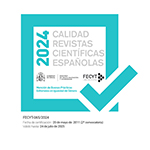Industriales de Buenos Aires e industriales del interior. Los manufactureros y los azucareros tucumanos a finales del siglo XIX y principios del XX.
Resumen
Una historiografía reciente ha recuperado un tema de discusión tradicional sobre el período agro-exportador argentino, el de los conflictos entre terratenientes e industriales, aunque creando una nueva versión. Como había indicado la historiografía tradicional, había diferencias entre los terratenientes y los industriales, no pertenecían al mismo grupo social, pero no es cierto que los terratenientes controlaran el poder político. Además, los industriales no eran tan débiles como la historiografía tradicional los había presentado. Ellos tenían influencia sobre el gobierno y con ella obtuvieron protección aduanera. Por tanto, no podemos seguir manteniendo que las políticas anti-industriales y el enorme poder de los estancieros fueran las principales características de la Argentina agroexportadora. El objetivo de este artículo es introducir un nuevo elemento en el análisis del problema de las características de las elites económicas argentinas. ¿Cómo cambia nuestra imagen de las elites económicas argentinas y particularmente de los industriales si los comparamos con otro grupo? El caso de los productores azucareros es significativo porque se trataba de un grupo poderoso que reclamaba constantemente protección y se quejaba de las tendencias librecambistas del gobierno nacional y de las elites del Litoral. Los industriales azucareros fueron algunas veces los portavoces más conspicuos de la llamada «industria nacional» y, sin embargo, su relación con otros productores industriales fue compleja. A pesar de compartir, en apariencia, intereses similares, como la defensa del proteccionismo, los desacuerdos entre ambos grupos eran más frecuentes de lo que podría esperarse.Descargas
Descarga artículo
Licencia
La Revista Complutense de Historia de América, para fomentar el intercambio global del conocimiento, facilita el acceso sin restricciones a sus contenidos desde el momento de su publicación en la presente edición electrónica, y por eso es una revista de acceso abierto. Los originales publicados en esta revista son propiedad de la Universidad Complutense de Madrid y es obligatorio citar su procedencia en cualquier reproducción total o parcial. Todos los contenidos se distribuyen bajo una licencia de uso y distribución Creative Commons Reconocimiento 4.0 (CC BY 4.0). Esta circunstancia ha de hacerse constar expresamente de esta forma cuando sea necesario. Puede consultar la versión informativa y el texto legal de la licencia.











